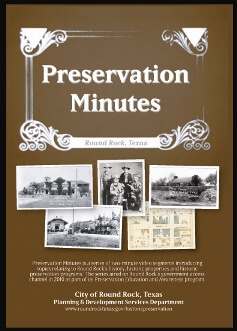Round Rock’s government access channel recently aired twelve short Preservation Minute video features through 2010 as part of the Preservation Education and Awareness program. Each segment introduces topics relating to Round Rock’s history, historic properties and historic preservation programs. For more information, contact Senior Planner Joelle Jordan at (512) 218-5422.
All twelve Preservation Minutes are now available on DVD for a $5 contribution to Round Rock’s historic preservation programs. DVDs are available at the Allen R. Baca Center and the Planning & Development Services Dept., 512-218-5428.
Segment 1: The History of Old Town
Round Rock was originally settled in the 1840s where a low water crossing where a stagecoach route crossed Brushy Creek. After the railroad was extended nearby, most of the businesses moved close to the depot, and the “Old Town” fell into decline, until owners began restoring them in the 1950s. Originally broadcast February 2010. Credits
Segment 2: The Arrival of the Railroad
In 1876, when the International & Great Northern Railroad extended its line just east of “Old” Round Rock, it also laid out a number of lots around the depot. The railroad set the stage for downtown Round Rock to become a center for local businesses. Originally broadcast March 2010. Credits
Segment 3: The History of New Round Rock
From the 1870s into the early 20th Century, “New Town” (Downtown Round Rock) grew to include a range of industries, shops, professional services, churches and a college. Originally broadcast April 2010. Credits
Segment 4: The Legend of Sam Bass
Sam Bass was a train and stagecoach robber who was finally stopped in Round Rock during an attempted 1878 bank robbery. During the attempted heist, he shot and killed Deputy Sheriff A. W. Grimes, was himself shot, and died the following day. Bass and Grimes both have roads named for them in Round Rock, and their graves are in the Round Rock Cemetery. The Sam Bass Shootout is reenacted each year during the Frontier Days Celebration. Additional information is available in a brochure (pdf) and web page. Originally broadcast May 2010. Credits
Segment 5: The Chisholm Trail
Round Rock was founded as a rest stop where the Chisholm Trail crossed Brushy Creek. The Trail primarily served as a route to drive cattle from grazing areas to the stockyards in Kansas and Missouri, until the railroad was extended to the area. First broadcast in June 2010. Credits
Segment 6: The History of Palm Valley
The Palm Family emigrated from Sweden and settled the area between Round Rock and Hutto in 1854, about ten years after Old Town Round Rock was established on the Chisholm Trail. The Palms, Nelsons and other families became prosperous farmers and helped finance the immigration of other Swedes to the area. The Palm Valley community grew to include its own railroad stop, a school, and the Palm Valley Lutheran Church and Cemetery. First broadcast July 2010. Credits
Segment 7: Historic Buildings in Downtown Round Rock
Most of the commercial buildings in Round Rock’s Commercial Historic District were built in the late 1800s after the arrival of the railroad in 1876, including the Broom Factory building, Jackson Furniture building, Morgan Miller building, Farmers State Bank (now Main Street Grill), Koppel’s Grocery (Quinn’s Bar), The Fair (Envy Salon) and Nelson Hardware building. The District was added to the National Register of Historic Places in 1983. First broadcast August 2010. Credits
Segment 8: Historic Homes in Downtown Round Rock
Homes built in Round Rock in the late 1800s and early 1900s reflect a range of styles, including Folk Victorian , Queen Anne, Classical Revival, Craftsman, and mid-century Ranch. The Nelson-Crier house and President’s house are featured in this segment. First broadcast September 2010. Credits
Segment 9: Local Landmarks
The Texas Historical Commission and National Register of Historic Places have designated a number of historic landmarks in Round Rock, including the Inn at Brushy Creek, St. Charles Hotel, Nelson Hardware building, Round Rock Broom Factory building, Olson house and A.J. Anderson house. First broadcast October 2010. Credits
Segment 10: Lost Landmarks
A number of Round Rock’s historic buildings are no longer with us. This segment highlights three of them: the Mexican School, Trinity Lutheran College, and the Adams Garage Motor Court. First broadcast November 2010. Credits
Segment 11: Documenting and Designating Your Historic Building
Properties can be designated as historic landmarks at the local, state and/or national level. Designated properties may be eligible for grants or tax incentives to restore and/or preserve the property. First Broadcast December 2010. Credits
Segment 12: Historic Preservation in Round Rock
The City of Round Rock has several programs to promote the preservation of its historic places for future generations, including historic designation, tourism and tax programs, and a Historic Preservation Commission to advise owners about designating and preserving their buildings. First broadcast January 2011. Credits
Acknowledgements
This program was made possible by a grant from the National Park Service as administered by the Texas Historical Commission. Scripts by McDoux Preservation LLC; video production by the City of Round Rock Communications Department.
Segment 1: The History of Old Town & Segment 2: The Arrival of the Railroad
Thanks to former Historic Preservation Commissioners Bob Brinkman, Earl Palmer and Lynn Smith for images used in this segment. Texas maps courtesy of Cartography Associates’ David Rumsey Map Collection; Old and New Town maps provided by the Planning Department.
Segment 3: The History of New Round Rock Thanks to former Historic Preservation Commissioners Bob Brinkman and Earl Palmer for images used in this segment.
Segment 4: The Legend of Sam Bass Thanks to local artist Micheal Hammons for the use of his painting “The Sam Bass Shootout” in this segment. Mr. Hammons may be contacted at micheal_hammons@att.net; the original painting is hanging in the Texas State Higher Education Center building. Video of the Frontier Days Sam Bass Shootout Re-enactment provided by the Communications Department. Other video courtesy of www.archive.com.
Segment 5: The Chisholm Trail Thanks to former Historic Preservation Commissioners Bob Brinkman and Earl Palmer for images used in this segment. Video clips courtesy Archive.org. Cattle images courtesy of the Library of Congress and old-picture.com. Portrait of Jesse Chisholm courtesy of the Oklahoma State Digital Library. Maps created by the City of Round Rock from multiple sources.
Segment 6: The History of Palm Valley Palm and Nelson family photos from: Images of America: Round Rock, by Bob Brinkman (2008); Round Tock, Texas: From Cowboys to Computers, by Karen R. Thompson (2002); Historical Round Rock Texas, by Karen R. Thompson & Jane H. DiGesualdo (1985) and Round Rock, Texas, U.S.A.!!! by the Round Rock Kiwanis Club (1972). Railroad advertisements courtesy of the Barker Texas History Center, The University of Texas at Austin.
Segment 7: Historic Buildings in Downtown Round Rock Thanks to the Round Rock Chamber of Commerce and former Historic Preservation Commissioners Bob Brinkman and Earl Palmer for images used in this segment. Photos also from Round Tock, Texas: From Cowboys to Computers, by Karen R. Thompson (2002); Historical Round Rock Texas, by Karen R. Thompson & Jane H. DiGesualdo (1985); Images of America: Round Rock, by Bob Brinkman (2008); and Round Rock, Texas, U.S.A.!!! by the Round Rock Kiwanis Club (1972).
Segment 8: Historic Homes in Downtown Round Rock Thanks to Earl Palmer, Wallace Rucker, Jr. and Keith Petersen for photos used in this segment. Additional photos from Lloyd’s Magazine (1927); Images of America: Round Rock, by Bob Brinkman (2008); Round Tock, Texas: From Cowboys to Computers, by Karen R. Thompson (2002); Historical Round Rock Texas, by Karen R. Thompson & Jane H. DiGesualdo (1985) and Round Rock, Texas, U.S.A.!!! by the Round Rock Kiwanis Club (1972).
Segment 9: Local Landmarks Thanks to Christopher Rose and Dee Ann Decker-Kincke from the Round Rock Flickr group, and to the Texas Historical Commission for some of the images used in this segment.
Segment 10: Lost Landmarks Sketch of the Adams Garage by Earl Palmer, photos from Round Rock, Texas, U.S.A.!!! by the Round Rock Kiwanis Club (1972), Bob Brinkman, Martin Parker and Trinity College’s 1919 yearbook, The Round Rock.
Segment 11: Documenting and Designating Your Historic Building Thanks to former Historic Preservation Commissioners Bob Brinkman and Earl Palmer for images used in this segment. Thanks to Martin Parker for the photo of the Nelson building and to Wallace Rucker Jr. for the photo of The Rock theater. Aerial photo of downtown via Bing.
Segment 12: Historic Preservation in Round Rock Thanks to Keith Peterson, Wallace Rucker Jr. and former Historic Preservation Commissioner Earl Palmer for photos used in this segment. Additional images from Round Rock, Texas, U.S.A.!!! by the Round Rock Kiwanis Club (1972). Aerial photo from Bing.com. Maps by the Planning Department and McDoux Preservation.
This project was funded in part through a Certified Local Government Grant from the National Park Service, U. S. Department of the Interior, as administered by the Texas Historical Commission. The contents and opinions, however, do not necessarily reflect the views and policies of the Department of the Interior, nor does the mention of trade names or commercial products constitute endorsement or recommendation by the Department of the Interior.
This program receives Federal funds from the National Park Service. Regulations of the U. S. Department of the Interior strictly prohibit unlawful discrimination in departmental Federally Assisted Programs on the basis of race, color, national origin, age or handicap. Any person who believes he or she has been discriminated against in any program, activity, or facility operated by a recipient of Federal assistance should write to: Director, Equal Opportunity Program, U. S. Department of the Interior, National Park Service, P. O. Box 37127, Washington, DC 20013-7127.against in any program, activity, or facility operated by a recipient of Federal assistance should write to: Director, Equal Opportunity Program, U. S. Department of the Interior, National Park Service, P. O. Box 37127, Washington, DC 20013-7127.



